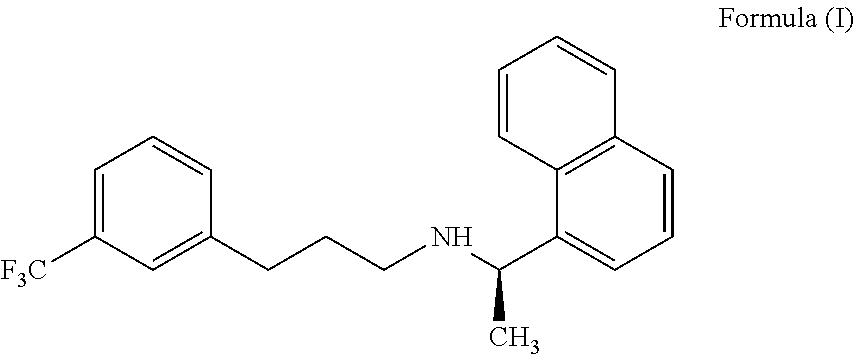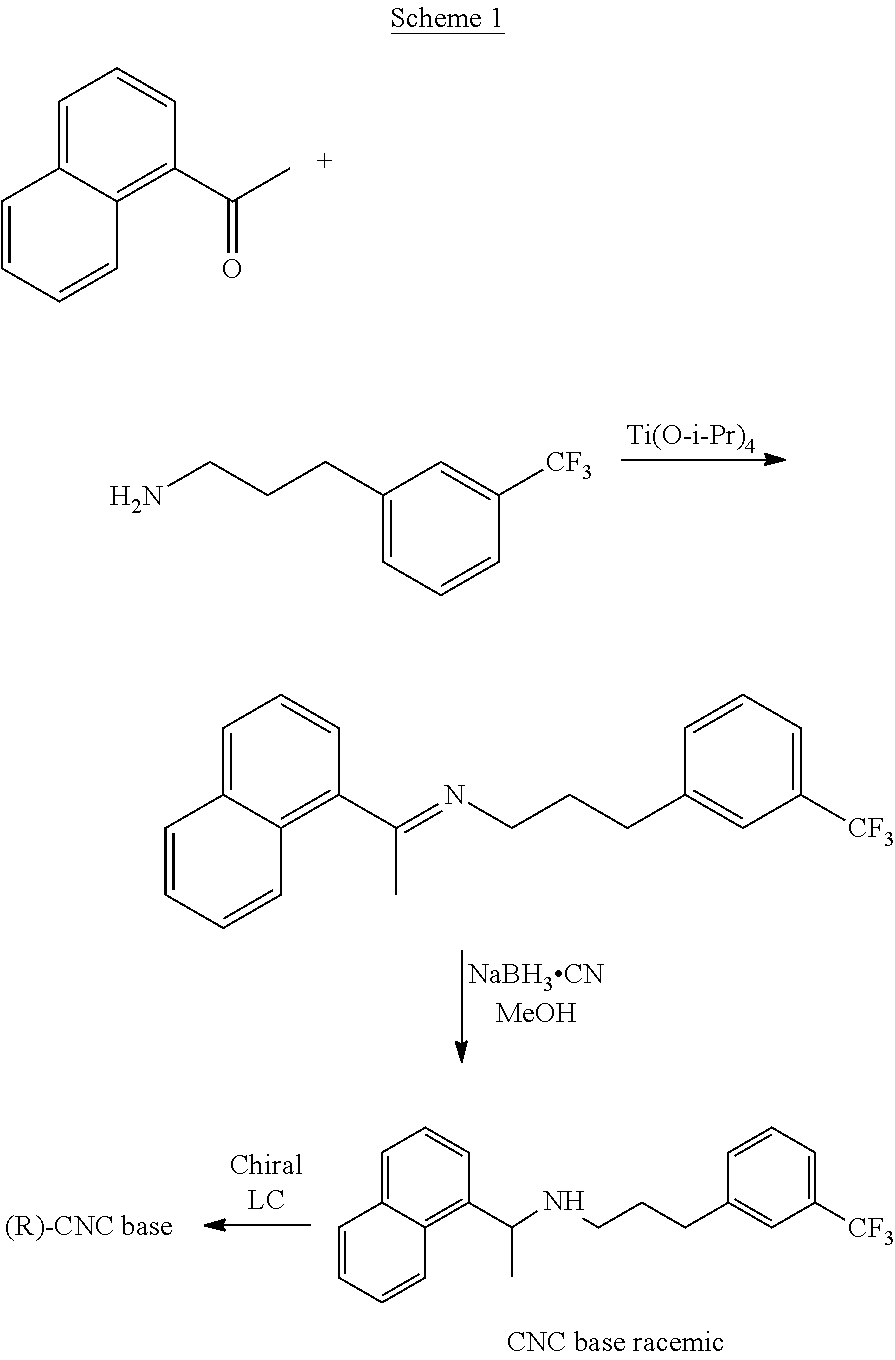Method for the preparation of cinacalcet and intermediates and impurities thereof
a technology of cinacalcet and impurities, applied in the preparation of amino compounds, isocyanic acid derivative preparations, organic chemistry, etc., can solve the problems of increased risk of cardiovascular death, increased risk of bone pain, hygroscopic and expensive, etc., and achieves enhanced management of process related impurities and higher yield
- Summary
- Abstract
- Description
- Claims
- Application Information
AI Technical Summary
Benefits of technology
Problems solved by technology
Method used
Image
Examples
example 1
Preparation of (1R)-1-(2-Naphthyl)-N-(Phenylmethylene) Thanamine derivative of Formula (IV)
[0201]To a stirred solution of (R)-1-naphthyl ethylamine (5 gm) in ethanol (25 ml), benzaldehyde (3.71 gm) was added with stirring at 25-30° C. The reaction mass was stirred at 55-60° C. for 5-6 hours. Upon completion of this reaction by TLC, the reaction mass was cooled to 25-30° C., and then to 5-10° C. The reaction mixture was maintained for 30 minutes. The precipitated solid was filtered, washed with ethanol (10 ml), and dried under vacuum to yield 7.1 gm (94.67%) compound of formula (IV) as a white crystalline solid.
[0202]MS; m / z 260 (M++1). 1H NMR (CDCl3): δ 8.44 (s, 1H), 8.27 (d, 1H), 7.80-7.87 (m, 5H), 7.48-7.51 (m, 3H), 7.41-7.42 (t, 3H), 5.37 (q, 1H), 1.74-1.76 (d, 3H). Related substances by HPLC 99.20%.
example 2
Step 2: Preparation of Cinacalcet of Formula (I)
[0203]The solid compound of formula (IV) (5.0 gm) of step-1 and the 1-(bromopropyl)-3-(trifluoromethyl)benzene compound of the formula (V) (5.66 gm) were reacted in presence of potassium iodide (0.2 gm) at 120-130° C. till the completion of the reaction which was monitored by TLC (16-18 hours). The reaction mass was cooled to 25-35° C., diluted with water (50 ml) and acetonitrile (10 ml); the pH of the reaction mass was adjusted to 1-2 using concentrated hydrochloric acid and stirred for 60 min. The resulting reaction solution was extracted with n-heptane (50 ml). The aqueous layer was separated, basified with ammonia till pH 9-10 and then extracted with toluene (50 ml), with 10% sodium metabisulphite solution (50 ml) followed by water (25 ml) and distilled off the toluene layer to get Cinacalcet base as thick syrup; 4.9 gm (71.0%); HPLC purity 99.1%; chiral purity: 99.90%.
example 3
Step 2: Preparation of Cinacalcet of Formula (I)
[0204]The solid compound of formula (IV) (5.0 gm) of step-1 and the 1-(bromopropyl)-3-(trifluoromethyl)benzene compound of the formula (V) (5.66 gm) were reacted in presence of potassium iodide (0.2 gm) at 120-130° C. till the completion of the reaction which was monitored by TLC (16-18 hours). The reaction mass was cooled to 25-35° C., diluted with water (50 ml), pH of the solution was adjusted to 1-2 using concentrated hydrochloric acid and stirred for 60 min. The resulting reaction solution was extracted with toluene (50 ml) and toluene layer was washed with 10% sodium metabisulphite solution (50 ml) followed by water. The toluene layer was separated and concentrated under vacuum to yield syrup, which is dissolved in the acetonitrile (10 ml) and water (50 ml). The pH of the resulting solution was adjusted to 1-2 using concentrated hydrochloric acid, washed the acidic aqueous layer with n-heptane (25 ml) and separated aqueous layer w...
PUM
| Property | Measurement | Unit |
|---|---|---|
| temperature | aaaaa | aaaaa |
| temperature | aaaaa | aaaaa |
| temperature | aaaaa | aaaaa |
Abstract
Description
Claims
Application Information
 Login to View More
Login to View More - R&D
- Intellectual Property
- Life Sciences
- Materials
- Tech Scout
- Unparalleled Data Quality
- Higher Quality Content
- 60% Fewer Hallucinations
Browse by: Latest US Patents, China's latest patents, Technical Efficacy Thesaurus, Application Domain, Technology Topic, Popular Technical Reports.
© 2025 PatSnap. All rights reserved.Legal|Privacy policy|Modern Slavery Act Transparency Statement|Sitemap|About US| Contact US: help@patsnap.com



